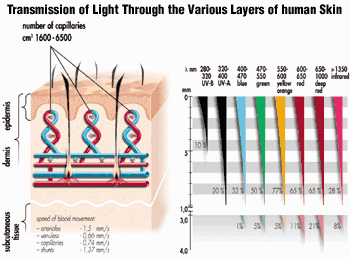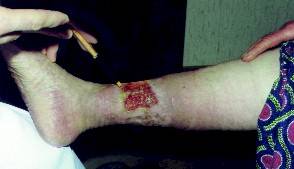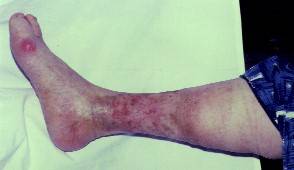Positive Health Online
Your Country

Light Medicine and the Future
by Steven Paul Warren(more info)
listed in light and colour, originally published in issue 50 - March 2000
It was really the advent of antibiotics which saw the demise of the use of light treatment on such a wide scale.[2,3] Now, as the medical profession finds itself exhausting the valuable resource of antibiotic therapy through its overuse, many doctors are looking for viable alternatives. Light therapy is beginning to rapidly find its place once again amongst the armoury of the modern physician.

Professionals and patients alike have welcomed changes in healthcare over the past couple of decades. In the scientific world there has been excitement over breakthroughs, with research highlighting the efficacy of a variety of treatments. Some of these harness the most modern, state-of-the-art techniques, while others draw on natural resources and mechanisms as old as time. Many of the most successful interventions are based on marriages of ancient and modern.
The history of light therapy dates as far back as the ancient Egyptians, Romans and Greeks, all of whom created healing temples based on a recognition of the therapeutic actions of light for healing the body as well as the mind and soul. However, many of the elements of such healing potential were attributed to religious metaphor. Yet as early as 1903, the twentieth century embraced the whole area of light for healing once again. The date 1903 is notable because it was in this year that physician Dr Neils Finsen was given the Nobel prize for medicine for both his investigation and clinical application of light therapy.[1]
Up until the end of the 1930s various forms of light-related therapies found widespread use in hospitals and clinics throughout the Western world. It was really the advent of antibiotics which saw the demise of the use of light treatment on such a wide scale.2,3 Now, as the medical profession finds itself exhausting the valuable resource of antibiotic therapy through its overuse, many doctors are looking for viable alternatives. Light therapy is beginning to rapidly find its place once again amongst the armoury of the modern physician.
As a therapist approaching the subject of light therapy to find help for chronic pain patients, I found myself initially cynical of the variety of claims made by clinicians using low-level laser therapy to achieve therapeutic changes on both chronic as well as acute medical conditions, which had traditionally defied the valiant attempts of various medical practitioners. From dermatological conditions to rehabilitation, chronic pain to even autoimmune diseases, the vast list of low-level laser contributions spread out before me. However, once I began researching through journal articles, discussing cases with practitioners, even talking with patients, my scepticism soon turned to amazement and my amazement had me sufficiently hooked to prompt me to want to learn more. Soon, I began travelling around the world to conferences on laser therapy; it was at one such conference that I encountered another breakthrough in this fascinating world of light therapy – Visible Incoherent Polarised or VIP light therapy.
Since that eventful meeting, my interest has culminated in working with VIP light therapy. This new phase of research has taken me almost around the world once again to visit the laboratories of doctors and professors who are ardently researching more and more applications of this simple and yet effective form of therapy.
At this point it is important to understand one fundamental element, that light therapy, in whatever form it is applied, does not cure anything. Here lies the key: the attractive element of light therapy is that when applied in the correct doses and including the relevant wavelengths, light actually stimulates the body's cells towards balance or to re-regulate themselves, resulting in cellular regeneration.
Years of systematic research carried out in centres of excellence all over the world now provides not only an understanding of the cellular mechanisms which respond to light therapy, but also the optimal doses which can achieve the desired clinical effects. For example, severe second degree burns patients not only heal faster, but these patients also recognise the benefits of their light treatment many years later as scars are often kept to a minimum.[4] Patients with chronic painful and unsightly leg ulcers are at last finding a treatment which encourages the body to finally heal.

Chronic leg ulceration before VIP light therapy treatment

Chronic leg ulceration after 4 months of daily application of VIP light
therapy combined with normal wound management
The scientific mechanisms underlying various light therapy treatments are finally being explained. Scientists have identified various biological effects that can be achieved as a result of light stimulation. These include:
- The activation of ATP production (ATP is an important storage and energy transfer mechanism in the human body);
- Increased support for the multiplication of collagen fibres;
- The enhancement of important specific enzymes involved in cell regeneration;
- Support for the lymphatic system for cellular regeneration;
- The beneficial development of new blood vessels;
- Creation of a significant increase of DNA and protein synthesis within the cells of the body.[5]
Clinicians have traditionally applied 'modern' light therapy through the use of low-energy or 'soft' lasers. These use a low-power energy and therefore do not have any thermal effect, acting in a stimulatory manner, in contrast to high-energy lasers which transform energy into heat and are used in surgery to vaporize or seam tissue. It was from the area of low-level laser medical research that the investigation and final clinical application of VIP light grew. In the 1960s, important research discovered exactly how light from lasers affects the biological system. In particular, it was discovered that the polarisation of light was a decisive factor, as it was this process which regulated cell membrane activity. Research by a Hungarian in 1981, Marta Fenyö, took the polarisation aspect of lasers for use as a complete biostimulatory treatment in its own right.[6,7]
VIP light uses the wavelengths between 400 and 2000 nanometers, which is similar to aspects of the spectrum produced by the sun, but omits the potentially harmful UV section of the sun's spectrum, thus using natural processes as part of the healing.[8]
In the same way that different vitamins and minerals have varying effects upon the body, so do each of the wavelengths of light.
Humans need a wide range of frequencies for physical, emotional and mental well being. To return to wound healing and dermatological problems to provide an example of this healing mechanism, we need to understand the research carried out by scientists on the cellular responses to VIP light.
Within each of the cells which compose the human body, there are smaller bodies called organelles. As the name suggests, these are tiny, organ-like structures each with its own particular function to perform. The body of each cell is covered with a cell membrane. This membrane is made up of fat and protein molecules, and is an important mediator between the internal and external world of the cell and its surroundings. VIP light works on this cell membrane, which in turn has an effect on the action of the cell contents or organelles. In effect, the polarised electromagnetic waves provided by VIP light optimise the cellular mechanism, acting as a trigger to help the body's own regenerative processes, thereby supporting healing on a number of levels.[9,10]
As I write, VIP light is now being used extensively in hospitals throughout the world to treat a wide range of both acute and chronic conditions. An eminent Russian professor, Kira Samoilova, has been carrying out extensive research on the cellular mechanisms involved in a whole host of light therapies for over 20 years. Her research findings in both low-level laser, UV light therapy and now VIP light therapy have demonstrated how visible polarised light does not just exert its action on the site being influenced by light therapy.
Intriguingly, through the gentle stimulatory action on the blood coursing through the fine capillaries under the skin area being treated, it also creates a photomodulatory effect [photomodulation is a term which describes how natural light optimises the immune response of the blood as well as enhances certain biopositive effects by increasing the supply of vital oxygen and energy to every cell].[11] This explains why, when treating a patient for a chronic non-healing leg ulcer, other positive changes can occur in terms of the healing of painful dermatological conditions. For example, a lady treated over a period of weeks for leg ulceration reported some time later that her eczema had improved. The fact that the eczema was on her arms and elbows and not on the leg site being treated demonstrates how the photomodulated blood carried the beneficial light energy to a distant site in her body.
Some of the common medical conditions currently being treated with visible polarised light are severe second degree burns,4 leg ulcers, psoriasis, eczema[12] and acne, as well as cosmetic applications for fine lines, crows feet, coarse pores on the face and even cellulite. In addition, the range of applications is not just restricted to the outer skin covering of the body. Rheumatoid arthritis, muscular strains and deeper tissue inflammations as a result of either sports injuries or disease respond favourably to both laser and VIP light therapy.
Hospitals in Germany are now combining VIP light with normal treatment protocols for their patients who suffer bedsores. After a shorter than usual stay in hospital, the individual is sent home with a small, portable VIP light system to carry on with the healing process.
Patients themselves or their district nurse simply apply the VIP light from a small, handheld unit for four minutes a day per area until the pressure sore is completely healed.
So where is the future of light therapy progressing? It is developing well into the millennium as more and more research takes us even beyond the cellular level, and molecular biologists explain features of an unimaginable world of energy medicine and quantum physics as this subject unfolds to its scientific rigour. I was first introduced to Professor Samoilova's work regarding the fascinating phototherapeutic effects of blood carried out in her research at The Russian Academy of Sciences in the Institute of Cytology, when her senior research scientist visited me in England at the end of 1997.
Since then I have travelled to St Petersburg, spent considerable time talking with Professor Samoilova, toured the laboratories and hospitals and spoken to senior doctors, patients and nursing staff about the advances in therapy which blood irradiation has achieved.
The results of research by the Hungarian physician, Professor Mesters early in 1966, showed many photobiologists and physicians the potential of light therapy for treatment.[13] Thirty years on, with further research and expansive clinical application, we are now in a position to take this pioneering work to the next stage of completion. What does this mean in terms of patients suffering from what were thought to be untreatable clinical conditions? After attending countless congresses and conferences, I have learned and understood that science is now attempting to explain what the clinicians have observed for thirty years. The mechanism behind the seemingly complex and yet simple cell biology of which all humans are composed no longer eludes scientific endeavour – systematic scientific research on clinical applications of this powerful and yet gentle resource is providing the foundation on which the future theories of cell metabolism and cell regeneration will be based.
Finally, at a recent European Congress of Dermatologists, I met with eminent professors and consultants from throughout the world who told me of the exceptional results they achieved using photobiology to treat chronic and acute dermatological conditions. It would be wrong to imply that light therapy alone cures – as I said before, it stimulates the body's natural healing potentials to regulate and regenerate.
Pharmacological and other treatment protocols still have their place in the armoury of the physician but with the addition of light therapy, the healing process can be potentiated ten fold.
References
1. Liberman J. Light Medicine of the Future. Bear and Company. Sant Fé, New Mexico. ISBN 1-879181-01-0. 1991.
2. Miley GP, Olney RC and Lewis HT Jnr. Ultraviolet Blood Irradiation: A History and Guide to Clinical Applications. Christopher Fellabaum. The Foundation for Blood Irradiation, Silver Springs, Maryland. 1933-1997.
3. Kime Z. Sunlight. World Health Publications. Penryn, CA. 1980.
4. Depuydt K, Monstrey S and Hoeksema H. Dept. of Plastic Surgery, Univ. of Gent. The stimulating effects of polarized light on wound healing and Avoiding surgery in the treatment of deep dermal burn wounds using polarized light. Presented at the 10th annual meeting of the European Association of Plastic Surgeons (EURAPS), Madrid, 21 May 1999.
5. Baxter GD. Therapeutic Lasers – Theory and Practice. Churchill Livingstone. (3rd edition) ISBN 0-443-04393-0. 1997.
6. Fenyö M. Theoretical and experimental basis of biostimulation by Evolite. ams Automatische Mess – und Steuerungestechnik – Enge Gasses. 1 – Postfach 1180D-8572 Auerbach/Opf – West Germany. Recent copies from BIOPTRON AG.Esslingerstrasse 32, CH-8617, Mochaltorf. Switzerland. 1982. and Fenyo M. Theoretical and experimental basis of biostimulation. Optics LASER Technol. 16: 209-215. 1984.
7. Kubasova T, Fenyö M, Somosy Z, Gazso LE and Kertesz I. Investigations on the biological effect of polarized light. Photochemistry and Photobiology 48 (4): 505-509. 1988.
8. Safety Report Duke University Durham North Carolina 27706 1992. and Federal Agency for Materials Research and Testing – Test Certificate and Report 1988. Copies from Bioptron AG. Esslingerstrasse 32, CH-8617, Monchaltorf. Switzerland.
9. Bolton P, Dyson M and Young S. The effect of polarized light on the release of growth factors from the U-937 macrophage-like cell line. Low Level Laser Therapy. Original Articles. pp. 33-37. John Wiley & Sons Limited. 1992.
10. Kubasova T, Horvath M, Kocsis K and Fenyö M. Effect of visible light on some cellular and immune parameters. Immunol Cell Bio 73 (3): 239-244. June 1995.
11. Samoilova K, Obolenskaya KD, Vologdina AV, Snopov SA and Shevchenko EV. Single skin exposure to visible polarized light induces rapid modification of entire circulating blood. 1. Improvement of rheologic and immune parameters. 2. Appearance of soluble factors restoring proliferation and chromosome structure in X-damaged lymphocytes. Proceedings of Effects of Low-Power Light on Biological Systems IV. SPIE-The International Society for Optical Engineering. Vol 3569. 1998.
12. Bazso E, Varju Sz, Szego P, Roza K and Apai P. Application of incoherent wide band polarised light to promote healing of wounds. Central Research Institute for Physics, Budapest, Hungary. ISBN 963 371 983 6. 1982.
13. Mester E, Spiry T, Szende B and Tota JG. Effects of laser rays on wound healing. American Journal of Surgery 122: 532-535. 1971.
Comments:
-
No Article Comments available